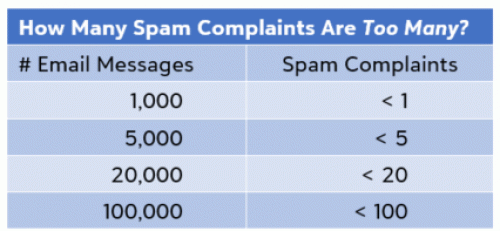There Are Consequences To Spam Complaints — Really!

Kathryn Hall
Blackbaud Employee








By Samantha McGuin
You've worked hard crafting your message, selecting your recipient list, and sending your message. The work is done, and you sit back to watch — what are surely going to be awesome — stats roll in on your email dashboard. Life is good. But wait…what's that number showing SPAM complaints?
SPAM complaints are reports Blackbaud gets from mailbox providers when recipients mark your messages as SPAM.
People use the "This Is Spam" button for a variety of reasons:
 Blackbaud calculates your SPAM complaint rate across all the messages you send. However, mailbox providers like Gmail don’t have the whole story like we do. They can only base their rate on how many messages you send to them. Let’s say you send a message to 80,000 recipients and only 80 mark it as SPAM. You think you’re doing good because your overall rate is .1%, but if 20,000 of those messages and 50 of the complaints are to Gmail, then your SPAM compliant rate with Gmail is a whopping 2.5%!
Blackbaud calculates your SPAM complaint rate across all the messages you send. However, mailbox providers like Gmail don’t have the whole story like we do. They can only base their rate on how many messages you send to them. Let’s say you send a message to 80,000 recipients and only 80 mark it as SPAM. You think you’re doing good because your overall rate is .1%, but if 20,000 of those messages and 50 of the complaints are to Gmail, then your SPAM compliant rate with Gmail is a whopping 2.5%!
Since a high number of complaints can impact your future email campaigns and whether they get delivered into inboxes, do your best to engage users so they are less apt to click the "report SPAM" button.
Finally, remember…SPAM complaints can happen to good senders. Your end goal should be to have zero SPAM complaints. Build your email program around your engaged recipients and get the benefits of increased deliverability.
Visit our Email Delivery website for more information on the impact of spam on your ability to get emails into inboxes -- and ways to improve your sender reputation.
You've worked hard crafting your message, selecting your recipient list, and sending your message. The work is done, and you sit back to watch — what are surely going to be awesome — stats roll in on your email dashboard. Life is good. But wait…what's that number showing SPAM complaints?
SPAM complaints are reports Blackbaud gets from mailbox providers when recipients mark your messages as SPAM.
People use the "This Is Spam" button for a variety of reasons:
- A spam complaint is the quickest way to no longer see your emails in their inbox.
- You've caught them in a bad mood and your message, along with the other 50 showing up in their inbox have sent them over the edge.
- They don't have the time to hunt for the itty bitty unsubscribe link hidden somewhere in your email message so they hit the VERY easy to find “report SPAM” button from the mailbox provider instead.
- They received 4 messages from you in the last two days and they want to send YOU a message that you’re acting like a spammer.
What's an acceptable spam complaint rate?
Industry best practices tell us that a SPAM rate at or below .1% (one tenth of one percent) is acceptable. If we put that into real numbers, out of a list of 100,000 recipients, 100 or fewer of them can mark the message as SPAM. Although 100 SPAM complaints doesn’t sound like a lot, that’s enough opportunity for folks who are having a bad day to impact your sender reputation. Blackbaud calculates your SPAM complaint rate across all the messages you send. However, mailbox providers like Gmail don’t have the whole story like we do. They can only base their rate on how many messages you send to them. Let’s say you send a message to 80,000 recipients and only 80 mark it as SPAM. You think you’re doing good because your overall rate is .1%, but if 20,000 of those messages and 50 of the complaints are to Gmail, then your SPAM compliant rate with Gmail is a whopping 2.5%!
Blackbaud calculates your SPAM complaint rate across all the messages you send. However, mailbox providers like Gmail don’t have the whole story like we do. They can only base their rate on how many messages you send to them. Let’s say you send a message to 80,000 recipients and only 80 mark it as SPAM. You think you’re doing good because your overall rate is .1%, but if 20,000 of those messages and 50 of the complaints are to Gmail, then your SPAM compliant rate with Gmail is a whopping 2.5%! Newton's Law
As Issac Newton told us, for every action there is an equal and opposite reaction. This holds true with SPAM complaints. SPAM complaints have consequences, and they vary by mailbox provider and email service provider (ESP).- Mailbox providers like Gmail make decisions on behalf of their customers — your recipients — to stop potentially unwanted messages from ever making it to inboxes. While they don't share their exact algorithms, given the recent focus on user engagement, we can assume that a high SPAM compliant rate will likely result in providers like Gmail delivering ALL of your messages directly to the junk folder.
- Email service providers like Blackbaud may or may not change the way they deliver your message based on SPAM complaint rates. To protect overall deliverability Blackbaud's system assigns your organization a grade — based on your SPAM complaint rate — to determine which IP addresses to use for your mailings. To calculate the rate, the system counts how many complaints it received about your messages over the past 30 days and divides the number by how many emails you sent. The system updates the rate each night and uses the current average to assign your grade whenever you send a message.
Since a high number of complaints can impact your future email campaigns and whether they get delivered into inboxes, do your best to engage users so they are less apt to click the "report SPAM" button.
- Only send to engaged recipients. Engaged recipients are people who want your emails and demonstrate their interest by signing up to receive them. They’ve also opened your messages within the last six months and possibly clicked links within them.
- Make unsubscribing easy. Mailbox providers don't punish you when someone unsubscribes from your messages — they typically don't even know when it happens. So, instead of placing your unsubscribe link at the bottom of your message in tiny print, put it at the top as well. Don't make people hunt for it because it’s there as a service to them. Remember, it’s really easy for users to click the "report SPAM" button.
If it’s easier for someone to report SPAM than it is to unsubscribe, then they’ll make an unnecessary complaint. When mailbox providers receive excessive numbers of complaints about your messages, they punish you by placing future messages — even for people who want to receive them — in recipient junk folders. To avoid decreased deliverability, make it just as easy for recipients to unsubscribe or manage their preferences as it is for them to mark your email as SPAM.
Finally, remember…SPAM complaints can happen to good senders. Your end goal should be to have zero SPAM complaints. Build your email program around your engaged recipients and get the benefits of increased deliverability.
Visit our Email Delivery website for more information on the impact of spam on your ability to get emails into inboxes -- and ways to improve your sender reputation.
0
Categories
- All Categories
- 6 Blackbaud Community Help
- 209 bbcon®
- 1.4K Blackbaud Altru®
- 395 Blackbaud Award Management™ and Blackbaud Stewardship Management™
- 1.1K Blackbaud CRM™ and Blackbaud Internet Solutions™
- 15 donorCentrics®
- 360 Blackbaud eTapestry®
- 2.5K Blackbaud Financial Edge NXT®
- 647 Blackbaud Grantmaking™
- 564 Blackbaud Education Management Solutions for Higher Education
- 3.2K Blackbaud Education Management Solutions for K-12 Schools
- 936 Blackbaud Luminate Online® and Blackbaud TeamRaiser®
- 84 JustGiving® from Blackbaud®
- 6.4K Blackbaud Raiser's Edge NXT®
- 3.7K SKY Developer
- 246 ResearchPoint™
- 118 Blackbaud Tuition Management™
- 165 Organizational Best Practices
- 238 The Tap (Just for Fun)
- 33 Blackbaud Community Challenges
- 28 PowerUp Challenges
- 3 (Open) Raiser's Edge NXT PowerUp Challenge: Product Update Briefing
- 3 (Closed) Raiser's Edge NXT PowerUp Challenge: Standard Reports+
- 3 (Closed) Raiser's Edge NXT PowerUp Challenge: Email Marketing
- 3 (Closed) Raiser's Edge NXT PowerUp Challenge: Gift Management
- 4 (Closed) Raiser's Edge NXT PowerUp Challenge: Event Management
- 3 (Closed) Raiser's Edge NXT PowerUp Challenge: Home Page
- 4 (Closed) Raiser's Edge NXT PowerUp Challenge: Standard Reports
- 4 (Closed) Raiser's Edge NXT PowerUp Challenge: Query
- 781 Community News
- 2.9K Jobs Board
- 53 Blackbaud SKY® Reporting Announcements
- 47 Blackbaud CRM Higher Ed Product Advisory Group (HE PAG)
- 19 Blackbaud CRM Product Advisory Group (BBCRM PAG)